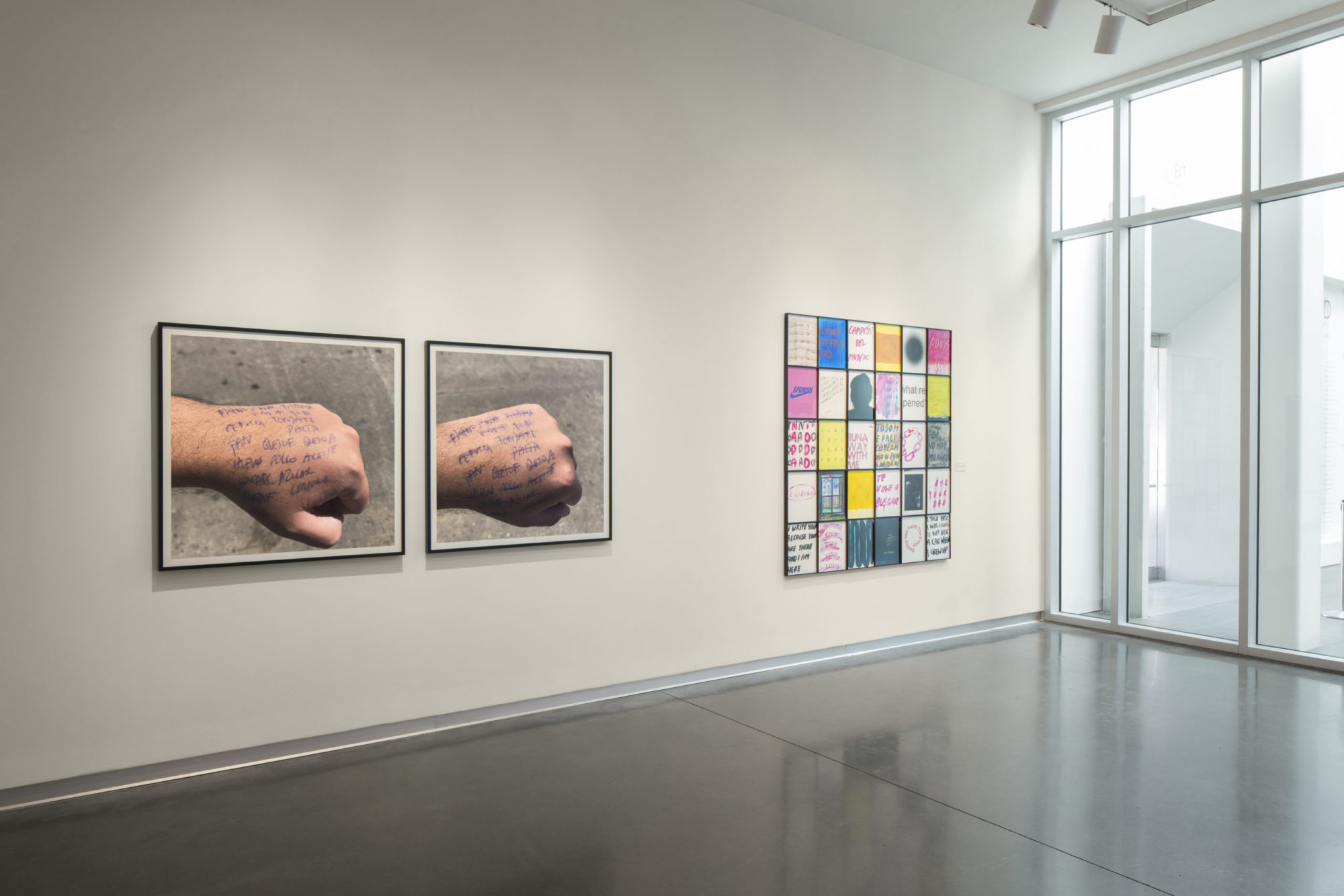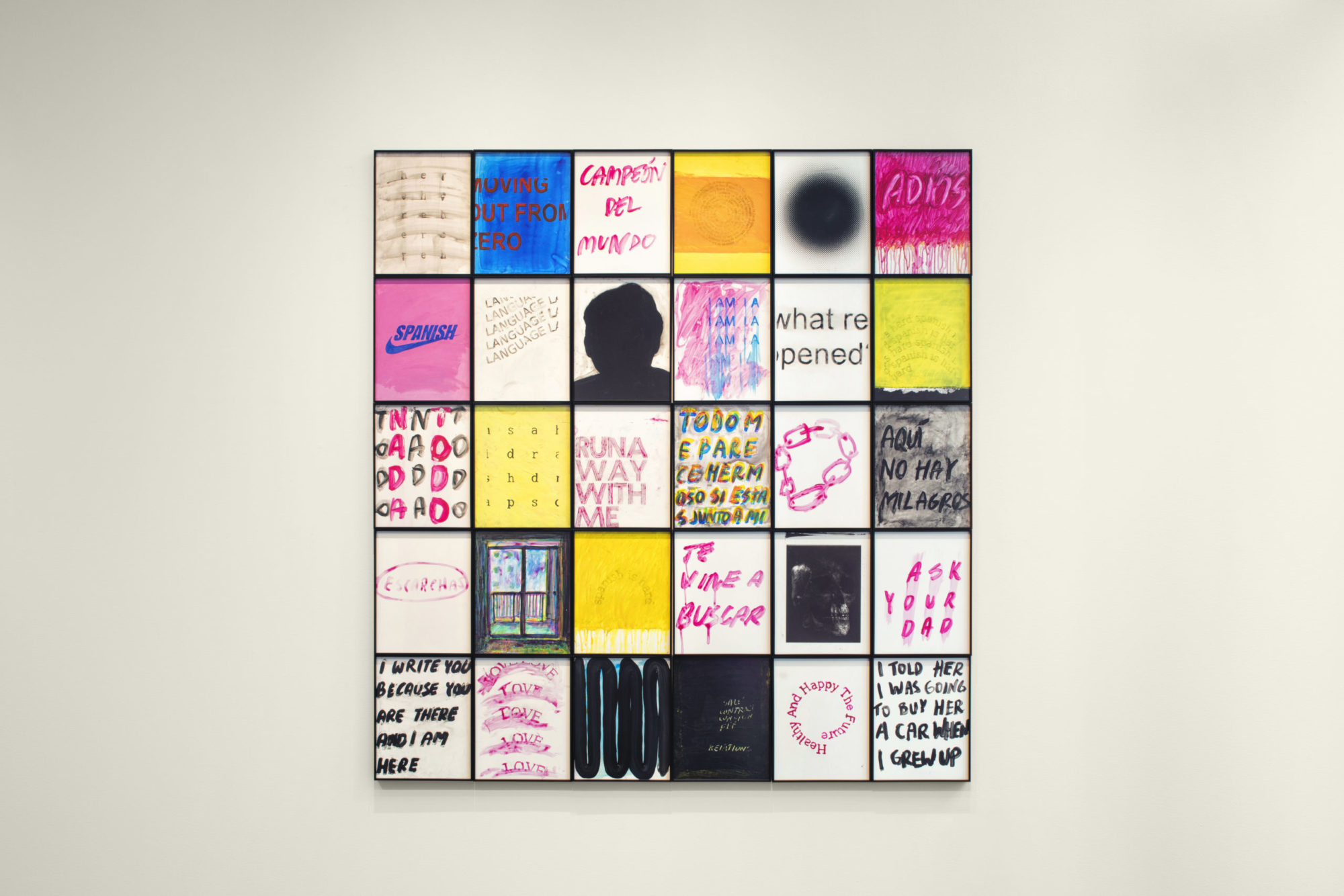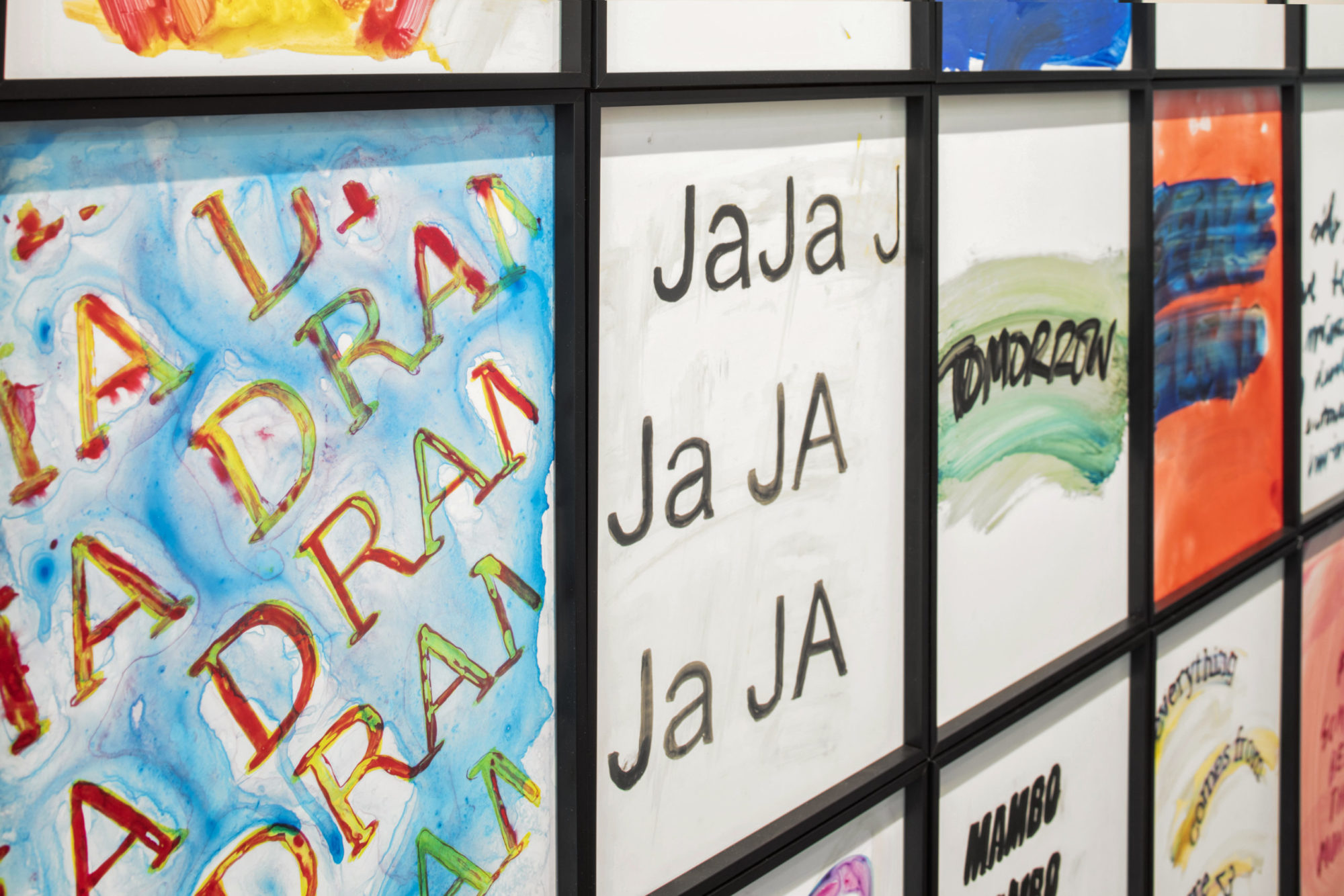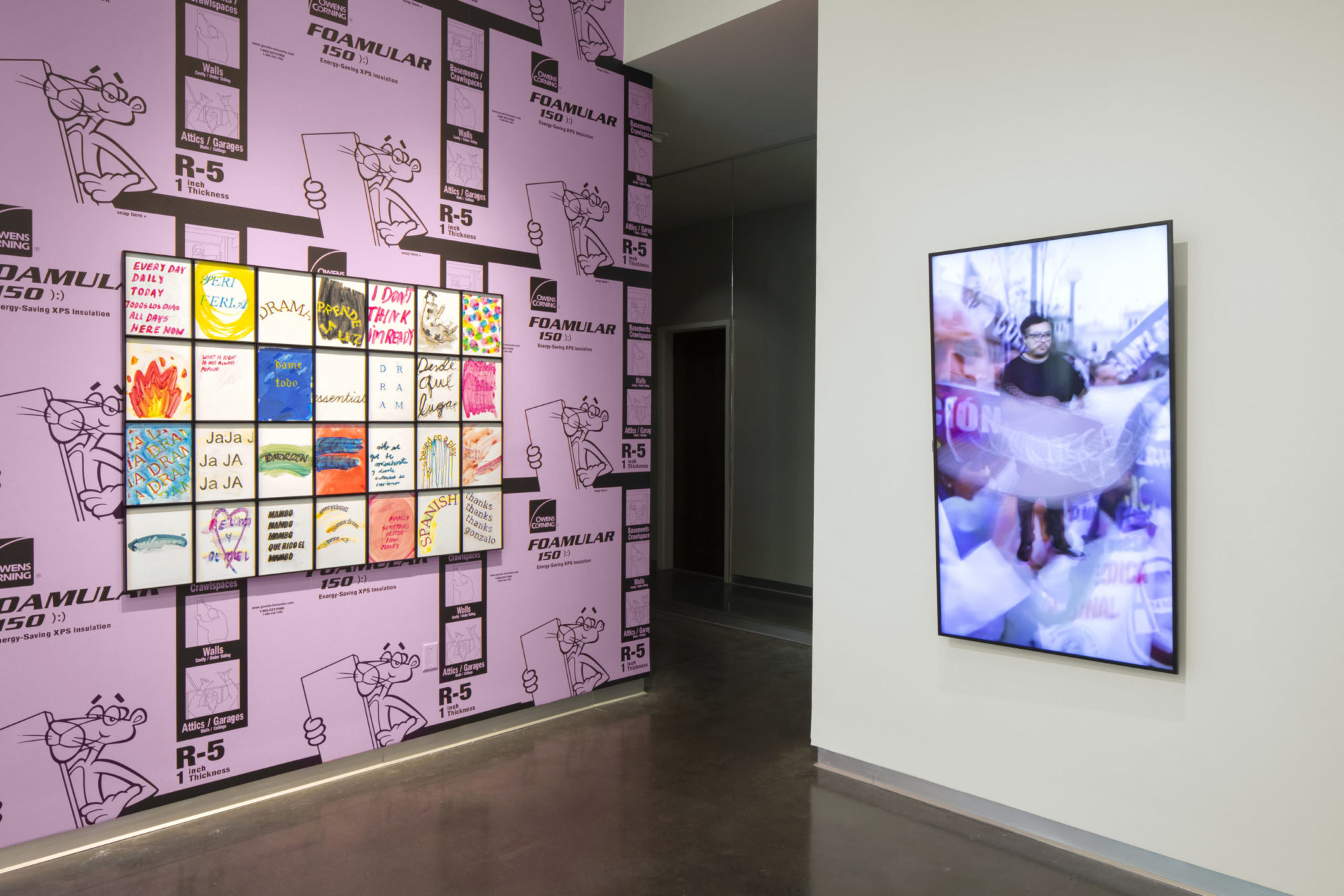Gonzalo Hernandez: ):)
Gonzalo Hernandez, ‘):)’, installation view, 2020 – 2021 [courtesy of SCAD MOA]
Share:
Trepidation over global upheaval and loss in 2020 created an uncertain backdrop for an artist’s first solo museum exhibition. A mixture of skepticism, excitement, and melancholy is allowed to exist in Gonzalo Hernandez’s exhibition, titled ):), at SCAD Museum of Art. The one-room show—staged in a space dedicated to SCAD alumni that has floor-to-ceiling windows dividing the gallery from the museum foyer—includes a noticeable diversity of mediums, including painting, photography, video, and vinyl installation. The eponymous work, ):) (gracias Todd) (2020), features the reversible emoticon—often used to denote mixed feelings or being simultaneously happy and sad—painted three times in primary colors on a sheet of Tyvek construction material. The three renderings overlap so that the emoticon is legible yet falls slightly out of register, so that the image visually vibrates, evoking the uncertainty and multiplicity of the emoticon’s meaning. This multilayered imagery is directly applied to a sheet of construction material stapled to the mounting board, cementing the theme of ongoing development found throughout the exhibition.
Gonzalo Hernandez, ‘):)’, installation view, 2020 – 2021 [courtesy of SCAD MOA]
Two groups of paintings—one immediately adjacent to ):) (gracias Todd), the other directly opposite it—are arranged in tight grids. These paintings feature bilingual text in the artist’s handwriting and handwritten replications of a font, modified logos, depictions of objects, and gestural mark-making. Individually, each painting feels intimate thanks to its scale, imperfections, and observable presence of the artist’s hand. Collectively, they are like notes or sketches, communicating an idea in the most economical terms. Text is sometimes cropped, marks bleed; these fervent gestures could create an incomplete or unfinished feeling, or a sense of indecipherability. Such feelings are ameliorated by their arrangement in a compact grid, which creates continuity between paintings. Where a word is cropped in one painting, for example, it is completed or shown in its entirety in another. A viewer can visually traverse the grid and apprehend it as one work composed of smaller moments. These works’ variability of interpretation, the co-existence of disparate emotions within them, and Hernandez’s strong voice gesture back to the exhibition title without directly referencing it.
Gonzalo Hernandez, ‘):)’, installation view, 2020 – 2021 [courtesy of SCAD MOA]
Gonzalo Hernandez, ‘):)’, installation view, 2020 – 2021 [courtesy of SCAD MOA]
PPP is a vinyl wall installation that replicates the surface of Owens Corning Energy-Saving Insulation and its iconic Pink Panther logo. The installation completely covers the wall upon which ):) (gracias Todd) and one grid of paintings hang, except for a small break in the pattern for the exhibition’s wall text. PPP serves as a formal unifier for the exhibition, echoing the pinks and blacks found in many of the other artworks, yet it also echoes the ambivalence introduced by the reversible emoticon. The installation effectively strips away the neutral façade of white walls and replaces it with what would normally be seen only during a building’s construction. This gesture toward the materials used to build and, by extension, the labor of those who work in construction, draws a direct connection between the labor of building and the labor of the artist’s making. As with the Tyvek pattern used as substrate in ):) (gracias Todd), the artist has intervened on the recognizable imagery. Portions of the text in the insulation pattern have been swapped for the artist’s website address and exhibition title, connecting PPP back to the artist himself. This slight modification, noticeable only upon close inspection, marks the artist’s presence—as if beneath the surface of the museum’s finished veneer.
The rear corner of the room features two photographs. In is a color photograph showing a grocery list written in Spanish on the back of the artist’s fist. Out is a nearly identical image with each item on the grocery list struck through. Lacking any sort of timestamp or date mark, these photographs evoke the incessant labor of regular tasks. As the titles imply, these mundane tasks are stressors, heightened by the ongoing pandemic, that mandate a no-nonsense mentality. Get in, get out. Documenting an inked grocery list brings new permanence to an ephemeral object. Hung close together but not touching, the photographs imply continuity between images that suggests a perpetual exchange but without promise of conclusion. The use of photography to capture a transient moment in the artist’s life continues the intimate setting created within the grids of paintings while simultaneously casting doubt over whether these stressors will ever abate.
Gonzalo Hernandez, ‘):)’, installation view, 2020 – 2021 [courtesy of SCAD MOA]
Sign is a vertical screen playing a looping video. The artist stands in the middle of the screen, wearing all black and handling a gray, arrow-shaped sign with the word “SUCCESS” written in white. The background of the video has been digitally removed and replaced with short clips of various achievements or accomplishments. Athletes competing, awards shows, and art fairs flash behind the artist. Although he is standing in front of scenes of success, the artist’s lackadaisical handling of the sign suggests a contrary attitude, a more complex definition of success. As the artist continues to swing his sign in front of these clips, caught in a perpetual loop, he suggests that success is something ever changing but always worth documenting.
Leia Genis is an artist and magazine editor currently based in Atlanta, GA. A graduate of the Savannah College of Art and Design with degrees in Painting and Sculpture, her artwork has been exhibited nationally and internationally at venues such as MINT Gallery in Atlanta, and the Ipswich Biennale in Ipswich, UK. In addition, she is an award-winning classical pianist and conversationally speaks French.



